Passive tracking antenna system
a tracking antenna and passive technology, applied in the field of passive tracking antenna systems, can solve the problems of omni-antennas, limited operating range, obvious movement parts,
- Summary
- Abstract
- Description
- Claims
- Application Information
AI Technical Summary
Benefits of technology
Problems solved by technology
Method used
Image
Examples
Embodiment Construction
[0022]Referring now to the drawings, wherein similar parts are identified by like reference numerals, FIG. 1 shows a perspective view of the preferred embodiment of the passive tracking antenna system 10. Antenna system 10 includes an antenna array 20 attached to diversity electronics 30. Diversity electronics 30 is attached to a mounting interface 40 having base feet 42. Diversity electronics 30 includes a touch pad 32, a display 34, and mode switches 36 on the front surface thereof. Antenna system 10 may be inflatable to allow for easy transportation. Further, if array 20 is large enough, diversity electronics 30 can be positioned within the center portion of array 20, below upward pointing antenna member 29.
[0023]Array 20 includes antenna sectors 21 each having an upper antenna tube 22 and a lower antenna tube 24 to provide a hardware formed viewing angle and an increase in sector gain without making the entire antenna sector 21 too large. Antenna tubes 22 and 24 each contain a s...
PUM
 Login to View More
Login to View More Abstract
Description
Claims
Application Information
 Login to View More
Login to View More - R&D
- Intellectual Property
- Life Sciences
- Materials
- Tech Scout
- Unparalleled Data Quality
- Higher Quality Content
- 60% Fewer Hallucinations
Browse by: Latest US Patents, China's latest patents, Technical Efficacy Thesaurus, Application Domain, Technology Topic, Popular Technical Reports.
© 2025 PatSnap. All rights reserved.Legal|Privacy policy|Modern Slavery Act Transparency Statement|Sitemap|About US| Contact US: help@patsnap.com



